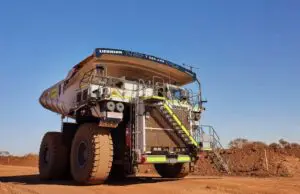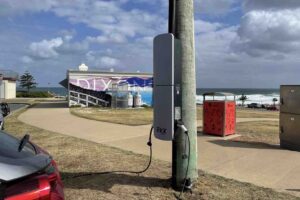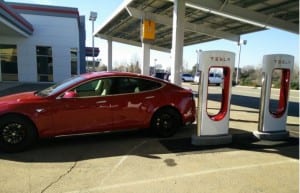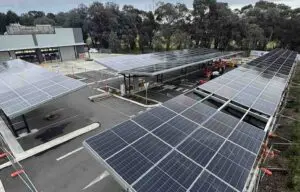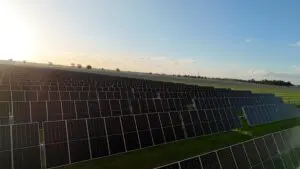It was entirely predictable, but shocking all the same. Within moments of Labor’s unveiling of an electric vehicle target of 50 per cent target of new car sales by 2030, commentators and guests on the Murdoch-owned Sky News channel went into melt-down.
It lasted all day and it will likely last through to the election and beyond, showing a remarkable ignorance and hostility to a technology that is only matched by their ante-diluvian views on wind and solar, battery storage, and climate science in general.
And it wasn’t just the right-of-everything commentators from “Sky After Dark” that were in on the act, even the respected journalist David Speers was caught nodding in agreement.
Consider this exchange between him and Graham Morris, the grumpy old conservative, lobbyist and former prime ministerial advisor who makes regular appearances on Sky and the ABC.
Labor details its climate change policy.@GrahameMorris2: The idea that in around 11 years half of Australia will be driving around in electric cars is ‘silly’.
It would take people driving from Sydney to Canberra 2 batteries.
MORE: https://t.co/zLoGQqasXf #speers pic.twitter.com/tjC5IL7yzI
— Sky News Australia (@SkyNewsAust) April 1, 2019
Morris: “It would take people from Sydney to Canberra two batteries.”
Speers: “This is the problem now, yeah.”
Morris: “Or From Wagga to Dubbo, you are better off walking!”
We’re not sure what Morris means by needing “two batteries”, or quite what he imagines an EV to be, or how fast he can walk. But the distance between the two cities is just under 300km – easily reached by most EVs new to the market in Australia and on their way over the next five to ten years.
The distance from Wagga Wagga to Dubbo is 406kms and is also within the range of most EVs, such as the newly released Kona. The distance from Sydney to Dubbo is 388kms, and from Sydney to Wagga Wagga it is 450kms.
That last distance might be a stretch, but there are fast-chargers at the halfway point in Goulburn, where you can add in another couple of hundred kms in the time it takes to have a coffee, or “fill the tank” or battery if you stop for a sandwich too.
In time, the fast-charging stations will be as common as petrol stations, including between Dubbo and Wagga Wagga. Morris should note the popular mayor of Dubbo, Matthew Dickerson, also has an EV. After having walked to Dubbo, perhaps Morris’ audience could ask the mayor for a lift back to Wagga in the EV for the return trip.
And yes, the costs of the EVs must come down. But they will, that’s what the policy is all about. Most analysts predict price parity in 5 to 7 years.
But it didn’t stop there.
There was the inevitable Craig Kelly, the head of the back-bench committee on energy whose defacto position is to oppose everything that isn’t fossil-fuelled.
Peta Credlin: The number one political issue is cost of living.
@CraigKellyMP: Labor know their climate change policy push up the cost of living, that’s why they’ve put this policy out to detract the Australian people’s attention.MORE: https://t.co/cvTuz39ghQ #credlin pic.twitter.com/2Ygs6GIuQc
— Sky News Australia (@SkyNewsAust) April 1, 2019
“Where do they think the power is going to come from to charge these electric cars,” Kelly wondered on the program hosted by Peta Credlin, the former chief of staff to former prime minister Tony Abbott.
Kelly’s concern was that all the charging would be done at night, and all of it would be coal-fired. By the time 2030 comes around, probably not – because the state will likely be at least 50 per cent renewable. And much of the charging can and will be done during the day, soaking up the “solar sponge” from excess solar power.
Credlin said Australian consumers would be forced to sell their current cars to buy electric to meet emissions standards. That is simply not true. It will be a target that applies to the average of new cars sold, and won’t be in by 2025, by which time it is likely that EVs will be competing with new fossil fuel cars on price anyway.
Andrew Bolt hopped in, also pursuing the line about where the power would come from to charge the electric vehicles – saying there was already insufficient capacity on the grid, and this would be worsened by EVs.
BOLT: Labor will force us to use more electricity when it’s going to give us less electricity. This sounds like disaster. So why is Labor doing this? Why all this pain? Labor claims it’s to save you from climate hell. #theboltreport @SkyNewsAust
MORE: https://t.co/aCsKs5iWK9 pic.twitter.com/LNej3aemwf
— The Bolt Report (@theboltreport) April 1, 2019
Well, nonsense. As the Australian Energy Market Operator has pointed out in its various studies, having a 50 per cent share of EVs in the fleet, not just new sales, would likely lift overall demand by around 15 per cent.
And this could be easily accommodated in a grid, as long as the charging – and particularly the time of charging – is well managed. Just like garden sprinklers, they can easily go on timers, and are quite sophisticated.
And as BloombergNEF points out, the EVs will have a considerable resource that can be used to put power back into the grid, if supply is ever short. Little power plants on wheels. .
And the silliness didn’t stop there. Murdoch commentators also popped up on the ABC’s The drum, where Caroline Overington displayed a poor grasp of history, observed by many on Twitter.
I’ll bet conservatives said the same about the internal combustion engine: “Country people will stick with the horse & cart because there’s no petrol stations in the bush” ???? https://t.co/2zbpD2NbPW
— Craig Emerson (@DrCraigEmerson) April 1, 2019
Actually, the first electric vehicles were made more than 150 years ago, and dominated the market until the fuel pump – and an easier form of distribution favoured petrol cars. Now, the tables are turning. There are brand new models, and increased range, but this is not a “brand new invention.”
Finally, we go to Angus Taylor, the energy minister, who said:
“The most popular car in Australia, the Toyota HiLux, is nowhere near that … I don’t know what tradies are going to do under Labor’s policies because there is no car that can do what they need to do that they can drive.”
Well, yes and no. Some tradies and farmers are making do already, like this farmer in north western NSW, who switched his own HiLux to battery, and hasn’t suffered from range anxiety, and has clocked up 100,000kms on a 10amp charge. His family’s other car is a Nissan Leaf electric.
Secondly, there are tradie vehicles on the way, such as the Rivian and the Tesla Ute – both of which are going to be providing stunning performance and range, and the ability to power their tools on site. And because of that, they will likely be taken up with gusto.
Surely, if tradies can manage the transition to clean transport, then the rest of the country can too.
If you want to learn more, you can go to our EV-focused website, The Driven, with stories on policy, model releases, reviews and road trips, and answers to frequently asked questions.


